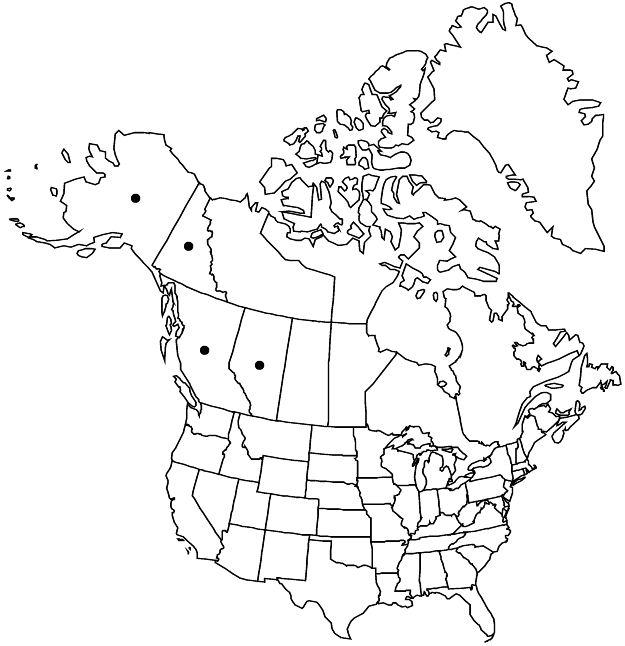Potentilla villosula
in A. I. Tolmatchew, Fl. Arct. URSS 9(1): 319. 1984.
Plants densely tufted. Caudex branches stout, sometimes ± columnar, not sheathed with marcescent whole leaves. Stems ascending to erect, 0.2–1.5(–2) dm, lengths 1.5–3(–4) times basal leaves. Basal leaves 1–5.5(–7) cm; petiole 0.5–3.5(–5) cm, long hairs common to dense, ascending to spreading, loosely appressed, sometimes retrorse, 1–2(–3) mm, soft, smooth, crisped/short-cottony hairs usually sparse, sometimes common, glands absent or sparse to common or obscured; leaflets overlapping, central broadly obovate to obtriangular, 0.8–2.5 × 0.6–2 cm, sessile to subsessile, base broadly cuneate, margins revolute, distal 1/2–2/3(–3/4) incised ± 1/2 to midvein, teeth 2–3(–4) per side, ± approximate to ± distant, surfaces ± dissimilar, abaxial grayish to white or yellowish white, long hairs 1.5–2.5 mm, cottony-crisped hairs ± dense, adaxial grayish green, long hairs abundant to dense, crisped hairs absent, sparse, or obscured. Cauline leaves (0–)1–2(–3). Inflorescences (1–)2–3(–4)-flowered. Pedicels 0.5–3(–5) cm in flower, to 4(–6) cm in fruit. Flowers: epicalyx bractlets broadly lanceolate to narrowly ovate, 3–7(–8) × 1.5–3(–3.5) mm, 2/3 to as wide as sepals, margins ± revolute, red glands absent; hypanthium (3–)4–6 mm diam.; sepals 4–7(–8) mm, apex acute or rarely acuminate; petals 5–10 × 6–12 mm, significantly longer than sepals; filaments 1.1–1.4 mm, anthers 0.5–0.8 mm; carpels 40–70, apical hairs absent or sparse (straight), styles narrowly columnar to conic-tapered, papillate-swollen in proximal 1/5 or less, 1–1.2 mm. Achenes 0.9–2 mm. 2n = 28 (Russian Far East).
Phenology: Flowering late spring to summer.
Habitat: Rocky alpine heaths, outcrops, scree and talus, gravel outwash plains, dry tundra, coastal bluffs, stabilized sand dunes, mostly on acidic bedrock
Elevation: 0–2900 m
Distribution

Alta., B.C., Yukon, Alaska, e Asia (Russian Far East).
Discussion
Potentilla villosula was included previously in P. villosa; the two overlap in the southern and western Alaskan coasts, where a transition is suspected to be associated with differing ploidy levels. The plants from this area with silky hairs and multiflowered inflorescences are assigned to P. villosa; P. villosula has thicker, stiffer, and less silky hairs, fewer teeth per leaflet, narrower bracts, fewer and smaller flowers with narrower epicalyx bractlets and sepals, and fewer achenes (sometimes with single apical hairs). While P. villosa is restricted to relatively rocky sites near the coast from western Alaska to Oregon, P. villosula often occurs on coastal sand dunes, farther inland, and/or farther to the north.
As circumscribed, Potentilla villosula is a major plant of Alaska, especially of the Bering Sea region. The species extends from Alaska and the Yukon to at least central British Columbia. Most of the range given by E. Hultén (1968) for P. villosa belongs to P. villosula. W. J. Cody (1996) accepted the name P. villosula for a common south-central Yukon plant, but the majority of the plants mapped by Cody probably belong to P. subgorodkovii (although the distinction between the two species needs more resolution). Provisionally included here are plants from southern and central Yukon south through the Canadian Rockies, possibly including the type of P. nivea subsp. fallax A. E. Porsild. Such plants tend to be significantly smaller overall than Alaskan P. villosula; at least some have straight hairs on carpel apices.
J. Soják (2004) believed that Potentilla villosula evolved from crosses between P. villosa and P. vulcanicola. The affinity with P. villosa is seen in the sericeous vestiture, number of leaflet teeth, and flower number and size, and with P. vulcanicola in the frequent occurrence of straight hairs on carpel apices in both species. Plants with columnar caudex branches, representing a significant part of the Alaskan material, have been called subsp. congesta. This morphology results from the persistence of marcescent whole leaves for several years (in typical P. villosula only sheaths and petioles are retained). This character suggests that P. subvahliana, with which the form called subsp. congesta is sympatric, may be part of its parentage. Potentilla villosula is accepted here in a fairly collective sense, possibly including several hybrid lineages, but with P. villosa a part of them all.
Selected References
None.